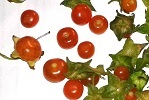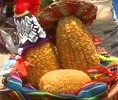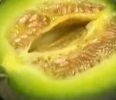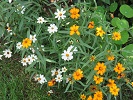New for 2025



Coleus mix (Plectranthus scutellarioides, Solenostemon scutellarioides)
Indonesia native bearing magnificient foliage in shades of lime green, bronze, burgundy, pink, etc. Click thumbnails for details. Quite easy to start from seeds and also easy to take care of. Tolerates shade very well. Starts blooming in July by growing long flower spikes with tiny blue flowers. Can reach quite a good size, close to 1 meter (including flower spikes). Flowers can be removed to promote side shoots. Shade, part shade en even full sun (they need then plenty of water). Very nice in pots. Side shoots can be snapped and used to make cuttings. Tender perennial grown as an annual.
Packet of 200 seeds: $2,49



Hyacinth Bean (Dolichos lablab)
Ornamental climber producing beautiful blooms followed by bright pinkish beans. Sow directly outside in late May, early June. Needs a support to climb on. Vigorous vines that can reach over 3 m tall. Blooms from July until late September. Full sun. "Ruby Moon".
Packet of 10 seeds: $2,49


Black Goji (Lycium ruthenicum)
Perennial from Central Asia bearing dark purple berries that can be eaten fresh or dried. Taste is simlar to sunberry or blackberry nightshade. Highly pigmented and full of antioxydants. Plant is a bush, 1,2 to 1,5 m tall by 1,8 m wide, covered with spines and small greyish green leaves. Berries start green, then turn purple and finally get almost black when completely ripe. Starts to bear fruits on the 3rd year. Full sun and well-drained soil. Self-fertile. Can tolerate poor soils. Perennial up to zone 5.
Packet of 50 seeds: $2,49
 Luffa
Gourd (Luffa
cylindrica)
Luffa
Gourd (Luffa
cylindrica)Can be grown for its edible gourds or for the sponges bearing the same name. Luffa vines can grow to be quite large. Provide space and support for climbing. Start seedlings inside in peat pots if possible. It is easier to grow for fresh gourds than for sponges (takes at least 50 more days for sponges and requires tunnels or a greenhouse). Gourds can be picked young and used in soups or stir fries. Popular in Asia, often called Taiwan okra. 80 to 90 days for edible gourds, and 150 days or more for sponges.
Packet of 15 seeds: $2,49



Jaltomato Aguaymanto (Jaltomata herrerae)
A jaltomato species bearing small orange berries with a sweet, tangy taste similar to goldenberries (Physalis peruviana). What stands out with this species is also its very unusual blood red nectar found inside each flower. Plant is bushy and grows many side shoots from which hangs the 1-cm berries. May need staking. About 50 to 100 cm tall. Sun to part shade. Sow seeds on surface, barely covering with soil, give light and keep at 20 C. Germination: 60-65% at 20 C.
Packet of 25 seeds: $3,49
Jaltomata herrerae is a wild species from Peru and Bolivia, growing at altitudes of 3000 to 3800 m. There is not much information though on how to grow it. Plants grown outside at our latitude did quite well but they produced fruits irregularly some years (sometimes early, sometimes later int the season ).
Growing it in pots allows to bring plants inside for the last fruits of the season to ripen. You can also keep potted plants in cold storage for next year.
When flowers are shaken, the blood red nectar starts dripping, bringing to mind... an image of bleeding
Other pictures of berries and flowers: 1, 2


Chilean Green Corn (Choclo Humero, Choclo Pastelero, Maiz Humero)
South American strain very well adapted to the north, producing uniquely stout cobs with yellow grains. Very wide ears of corn, with about 22 rows of grain compared to an average of 16 for standard corn. Can be harvested like sweet corn, at the milk stage*, ot later, when dried, to make corn nuts**. Grows well, good yields. Chilean Green Corn, Choclo Humero. About 90-95 days.
Packet of 15 seeds: $2,99
* Milk stage (sweet corn): harvest when silks are brown and dried. If you pierce the grains, they should then leak a creamy liquid. Boil or grill, like sweet corn. Tasty but less sweet than regular corn. In Chile, it is used to make humitas (basil tamales) and pastel de choclo (corn pie).
** Corn nuts: pick when completely dry. Roast or fry grains, then add salt. You will hear grains popping, like popcorn, but they only slightly increase in size. Corn nuts, also called cancha and maiz tostado in Latin America, are a delicious and nutritious snack, and a very nice change from popcorn. Photo of homemade corn nuts.



Chullpi Corn (Ch'ullpi, Chulpi, Chulpe, Chulpe Chulpino, Chullpi Amarillo)
Andean strain producing small ears measuring 7 to 12 cm long, with a distinct cylindrical-conical to globular shape often reminiscent of a pine cone. Used mainly to make cancha*, also called cancha serrana, canchita or maiz tostado (toasted corn), but more widely known in North America as corn nuts. Can also be harvested immature (for miniature corn) or at the milk stage (sweet corn). Large plants with purplish green foliage.
Warning: very late strain producing huge plants but no ears here in Quebec**.
Very late 140-145 days.
Packet of 25 seeds: $3,49
Chullpi corn is grown at an altitude ranging from 2400 to 3400 meters and can be found in several Andean countries: Columbia, Peru, Bolivia, Argentina and Chile.
* Cancha is a poplar snack in Peru and also served as a side dish for meals such as ceviche. It is a delicious and nutritious treat and a very nice to change from popcorn. To make your own corn nuts, harvest dried ears, remove grain, roast or fry, and add salt. Photo of homemade cancha (corn nuts).
** Chullpi had not time to produce in our climate. But you might have a chance to grow it successfully if you live in an area with a longer growing season (Florida, southern France, etc.). Fortunately, we offer a strain that is quite similar and grows very well in the north: see Chilean Green Corn above.


Black Waxy Corn (Sticky Corn, Glutinous Corn, Zea mays Group ceratina)
Waxy corn originates from Asia and is known for its unique chewy, sticky texture. Can be found in some Asian markets, either fresh or frozen. With its unusual chewy texture, this corn can be actually quite fun to eat (like gummy bears or tapioca pearls). Taste is sweet and similar to sweet corn, though the black strain we offer seems to be a bit sweeter than the other ones. Nice, uniform plants, well-formed ears, about 16-17 cm long. Can sometimes be a bit tricky to time harvest.* Black strain, highly pigmented. About 95 days.
Packet of 30 seeds: $2,99
* Pick ears when husks are dried and brown. Grain should then be milky at this stage. Then boil or grill. Note that this corn can also be picked much later, when it's dry or half dry, to make very nice novelty purple corn nuts (photo).
** Looks similar to "Japanese black waxy corn" used to make mochis (desserts).
Make sure to grow waxy corn alone and far away from other types of corn, otherwise the recessive amylopectin gene will not express itself if cross-pollination occur.



Cuzco Giant Red Corn
Peruvian variety with beautiful, huge red grains sometimes reaching over 2 cm long. Share the same lineage as the famous Cuzco Giant White Corn (Urubamaba Blanco, Paraqay, Cusco Gigante*), which has the same type of grain. Used mainly for mote (hominy), cancha (corn nuts) or for choclo (steamed corn). Ears are 15 to 17 cm long. Plants grow to be gigantic, reaching over 4,4 m (14,5 feet!).
Warning: very late, at 140 days. Does not have time to grow ears in Quebec.**
Packet of 8 seeds: $3,49
* There is some confusion pertaining to Andean corn nomenclature. The strain we offer was attributed to the Sacsa variety but its grain is more uniform, darker and not much variegated. It actually looks more like Cuzco Gigante Chaminco or perhaps Puka anf Puka T'ika. One thing's for sure: it is part of the Cusco Gigante "series", which already exists in several sub-cultivars of different shades (blanco, amarillo, morado, etc.). The Cusco Gigante corn is only grown in a small area of Peru, comprising the Sacred Valley and the Cuzco Valley, at an altitude varying from 2650 to 3000 m.
Other picture of giant grain.
** Does not have time to produce ears in the north. On the other hand, if you live in an area with a longer growing season, you might stand a better chance of succeding. Obviously, you can always try it as an ethno-botanical curiosity or a convversation piece, solely for the sheer size of the plants: indeed, the ones we grew in 2024 reached over 4,4 m (14,5 feet) with thick stalks over 4 cm wide. Right thumbnail: Cuzco Giant Red stalks reaching over roof top.


Pescorunto Corn (Pisccorunto, Pisqu Runtu)
Peruvian strain whose name in Quechua means "bird's egg", referring to its gorgeous blueish-purple mottled grains (click thumbails for details). Small, stocky ears, 11-12 cm, with a distinct cylindrical-conical to globular shape that is often reminiscent of a pine cone. Can be eaten toasted (corn nuts), ground (corn flour), steamed (choclo) or cooked (mote). Tall plants, over 3 m. Alpine variety growing at the highest elevations (+ 3000 m) and under fairly cool temperatures (mean daily average: 4 Celsius).
Warning: late (130 days) and not very well adapted to short seasons*
Packet of 20 seeds: $3,49
* One plant out of 3 though had time to produce a single ear in 2024. Obviously, if you live in an area with a longer growing season, you increase your chances of successfully growing Pescorunto corn.

Melon Hami (Yellow Hami, Golden Hami (C.melo group Inodorus var. ameri))
Melon strain from China characterized by its very sweet taste and its crunchy texture reminiscent of a watermelon. Think honeydew but with a denser and crunchier flesh. Golden yellow fruits with more or less reticulated skin (semi-embroidered). Variable shape, ranging from rounded to elongated oval, to more or less nutmeg-shaped. Average size: 15 to 18 cm cm in length. Pale orange flesh, of a good thickness, not very odorous but quite sweet. Golden Hami strain. 80-90 days.
Packet of 20 seeds: $2,49
Hami melons are nearly 2,000 years old and originate from the Xinjiang region in northwest China. They are grown there at high altitudes; they are also called "snow melons". They are said to have a good storage capacity under cold temperatures (3-4 C).


Melon Jade Apple (Green Jade, Emerald)
Chinese and Taiwanese variety bearing grayish emerald small fruits with a sweet, crunchy green flesh. Thin skin that can be eaten. Fruit is slightly striated, oval-shaped to nutmeg-shaped, with a flattened belly and a characteristic "navel". Size of a grapefruit. Good production. Very similar to the varieties Ruyu, Cui Niu and Crispy Treasure. Sometimes called simply "emerald melon" or "green jade melon". Early: 70 days.
Packet of 15 seeds: $2,99
Chinese melons are often called "apple melons" due to their small size, thin skin and crispy flesh.


Melon Wah Mibao ("Nectar melon")
Chinese strain with oval to nutmeg-shaped yellow fruits covered with green stripes, and about the size of a large grapefruit. Crunchy white flesh with a very sweet flavor, Its name translates to "nectar melon". Thin skin that can be eaten. Fruits easily from lateral stems. Chinese melons are often called "apple melons", due to their small size, thin skin and crispy flesh. Early: 70 days.
Packet of 15 seeds: $2.99


Monarda Fistulosa (Wild Bergamot)
Perennial with lavender blooms much appreciated by pollinators (bees, butterflies, hummingbirds). Flowers and foliage have an aromatic scent and can also be used for tea (bergamot flavor, Earl Grey style) or for their medicinal properties. Flowering: July to August. Begins to flower in its 2nd year of growth. Well-drained soil. Sun to partial shade. Native hardy perennial. Zone 3.
Packet of more than 100 seeds: $2.49
Pepper Aji Confusion
Capsicum baccatum with pods of variable and intriguing shapes. Each plant produces fruits of different shapes – and even within the same plant, there is some variability, although to a lesser degree. The only consistency is that they are all creamy white in color. In fact, the latter barely change color when fully ripe (they then become a little more yellowish). Large plants of 1 meter with drooping stems. To achieve a more beautiful effect and a mix of shapes, you can group several plants together. Be careful, peppers are quite hot. Germination: +- 60%%
Packet of 15 seeds: 2,99


Pepper Chilhuacle Black (Chilhuacle Negro)
Dark green pods turning dark chocolate brown when fully ripe and used mainly dried to make mole negro. Spicy and fruity flavor, with notes reminiscent of raisins, cocoa, molasses and tobacco. Medium-sized peppers (8 cm), more or less triangular in shape, with a leather-like skin.. Easy to dry. Very good as pepper flakes or paprika. This variety originating from Oaxaca produces quite well in Quebec and this is most likely due to the work of Adaptive Seeds, who selected it for the climate of the American northwest. 95 days.
Packet of 10 seeds: $3.49



Pepper Peppapeach Stripey
Beautiful pale peach pods with red stripes. Each one is unique and displays a different pattern. Click thumbnails for details. Sweet and hot flavor. This variety has smaller plants than most baccatums, reaching about 60-70 cm high. Can be grown in pots. About 90 days. Germination: 65%
Packet of 15 seeds: $2,99

Pepper Sugar Rush Peach
C. baccatum selection with long, pale peach-orange pods. Sweet and tropical taste, but also quite hot (50,000 to 100,000 Scoville units). Tall plants of 1 m with long drooping stems, typical of baccatums. The 10-cm peppers ripen gradually from yellow to peach-orange. Relatively early for a baccatum, at 60 days (yellow) and 80 days (peach). Looks like a paler and earlier version of the peruvian Aji Amarillo. Germination: 65%.
Packet of 15 seeds: $2,99
Sugar Rush Peach would probably make a nice dried pepper, like Aji Amarillo, with its sweet, fruity and spicy taste.


Pepper Thai Ornamental
A more compact variety than the standard thai pepper, with bushy plants about 30 to 35 cm high. Pods are also smaller, measuring 2 to 2.5 cm long. Easy to grow in pots, either alone or in groups. Obviously, pods are perfectly edible, even if it's called "ornamental" (but be careful, they are quite hot). About 90 days.
Packet of 20 seeds: $2,49



Pepper Zebrange
Wonderful orange peppers with red stripes. Very beautiful. Each pod is slightly different (click thumbnails for details). Taste is rather hot. Tall plants reaching 1 m high, with long drooping stems bearing 6 to 9-cm long pods. About 10 to 15% of plants produced completely red fruits. Capsicum baccatum. About 90 days.
Packet of 15 seeds: $2,99

Pepper Chervena Chushka (Chervena Chujski)
Bulgarian variety with superb sweet peppers featuring a particularly firm, dense and crispy flesh. Sweet flavor. Bright red fruits 10 to 15 cm long, with 3 lobes, ending in a point at their end. Walls are 4 to 5 mm thick. Traditionally used in Bulgaria for the preparation of roasted peppers, but equally good in salads or for making stuffed peppers. Also called Chervena Chujski. 85 days.
Packet of 15 seeds: $2,49


Tomato Gelbe Wurmchen (Wildtomate Gelbe Wurmchen)
German strain with small golden fruits in the shape of a drop or an elongated pear. The 3-cm tomatoes have a particularly firm and crispy flesh, and a sweet taste. To obtain an even sweeter taste, wait until berries become very ripe and change from light yellow to golden-orange. Bushy plants, like wild tomatoes (L. pimpinellifolium), producing loads of side shoots. Grows well in a tomato cage. The shape of the fruits varies somewhat between plants, some producing slightly more elongated fruits than others. The name can be translated as "wild tomato with yellow worms" (?!). Rather firm and cripsy flesh. Wildtomate Gelbe Wurmchen. About 70 days.
Packet of 15 seeds: $2,99
 Tomato
Lucfichoise
Tomato
LucfichoiseMultiflora variety producing small striped tomatoes with orange-yellow skin. Some also sometimes take on a pinkish hue, as shown in the photo. Oval to pear-shaped berries, 3 to 4 cm long, with a sweet flavor when fully ripe. Multiflora type, but with smaller clusters of tomatoes (no more than 15 fruits per cluster). Named after Luc Fichot, a Belgian collector. About 70 days.
Packet of 20 seeds:
These tomatoes become sweeter when they are very ripe; the only problem is that they are also prone to cracking at that stage. To avoid this problem, pick them before they are fully ripe (when they start to turn) and let them finish ripening inside. You will get then smooth fruits.


Tomato Maple Syrup
Russian variety whose name translates to "maple syrup" (?). Produces large, beefsteak-style fruits with a round-flattened shape and slightly ribbed shoulders. Skin starts green and turn brownish red. Flesh is green and pink, with a complex flavor. 80 days. Limited quantities.
Packet of 8 seeds: $2,99



Tomato True Colours
A beautiful tomato displaying a magnificient range of greens, yellows, oranges and reds. Beefsteak type, with a somewhat variable shape, round-flattened to slightly elongated. Rich and complex flavour. Indeterminate plants with potato foliage (grandifolium). Fruits can sometimes crack under certain conditions (if you ever have this problem, just harvest them before they are fully ripe (when they start to turn) and let them ripen indoors. You will then get smooth fruits, as shown above). A masterpiece tomato strain selected by Karen Olivier from British Columbia. About 75 days.
Packet of 15 seeds: $2,99


Zinnia Linearis (Zinnia angustifolia)
Small 4-cm flowers in shades of white, yellow and orange. Compact plants, 40 cm high, with narrow leaves and single flowers reminiscent of coreopsis. Like other zinnias, it has a long blooming period, extending from July until frosts. Also called classic zinnia or narrowleaf zinnia. Native to Mexico. Tolerates a certain degree of drought and heat. Full sun, partial shade. Annual.
Packet of about 50 seeds: $2,49


Zinnia Marylandica
Zinnia species featuring white flowers with a pink star at their center. Like other zinnias, it has a long blooming period, extending from July until frosts. Will tolerate some drought and heat. Medium-sized flowers (6-7 cm) on fairly compact plants. Height: 30-50 cm. This variety is similar to Starlight Rose but with seemingly more variability between plants. Full sun to partial shade. Annual. Zinnia marylandica.
Packet of 30 seeds: $2,49
Back for 2025

Eggplant Kamo
Japanese variety known for its dense flesh and rich flavor. Dark purple, rounded fruits, slightly flared. Average size: 10 to 15 cm in diameter, 300 to 400 grams. The Kamo eggplant is a highly regarded heirloom variety in the Kamo region of Kyoto, where it has been cultivated for hundreds of years. "Kamo nasu". 65 days.
Packet of 30 seeds: $2,49


Ipomopsis rubra
Superb scarlet flowers forming delicate spikes on top of a finely divided foliage. Grow in clusters for a spectacular effect. Click thumbnails for details. Height: 60 cm to 1.5 m. Attracts hummingbirds. Tolerates drought well. Full sun, very well-drained soil. Reseeds easily. Biennial for zone 6, but treated as an annual in zone 5 here in Quebec (it blooms easily the first year).
Packet of 30 seeds: $2,49

Melon Kajari
A variety from northern India with beautiful orange-copper fruits striped with green lines. Pale green, sweet, honeyde-like flesh. Small size: 10-15 cm. These melons have a very unique look that is reminiscent of certain gourds. Early. 70 days. Limited supply.
Packet of 10 seeds: $3,49


Pepper Zavory
Delicious peppers with a fruity, tropical aroma simlar to a habanero, but with just a bit of heat. One could say that they have just the perfect balance between flavor and spiciness. They are indeed very tasty. Good production of 4-cm bright red fruits. Just a bit hotter than Aji Dulce or Trinidad Perfiume. A very nice variety. 90 days.
Packet of 10 seeds: $3,49



Salvia farinacea (Blue Sage)
Annual. Dense clusters of blue-purple blooms growing on long flower spikes. When flowers are rubbed between your fingers, they give off a delicious citrus scent reminiscent of grapefruit. Magnificent cut flower, keeps its colors. Victoria cultivar, with a compact shape (40 cm). Abundant and constant blooming, from July to frost. Tolerates a certain degree of drought. Tender perennial (zone 8) treated as an annual. Prefers full sun, tolerates partial shade.
Packet of 50 seeds: $2,49


Tomato Taxi
Excellent yellow early variety, well adapted to short seasons. Beautiful deep yellow fruits, 4 to 5 cm in diameter, round to oval in shape. Perfect tomatoes, smooth and without defect. No cracking. Very pleasant flavor, not bland at all. Very good refreshing taste. Small compact plants of 70 cm. Without a doubt, one of the best yellow open-pollinated tomatoes: beautiful, tasty and early. 60 days.
Packet of 15 seeds: $2,49
![]() Home page
Home page
![]() Return to catalog
Return to catalog
![]() Page en français
Page en français